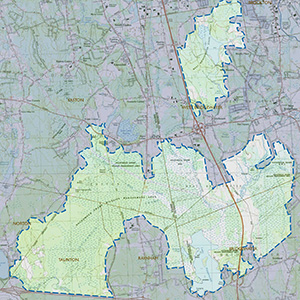Important Bird Area Sites in Massachusetts
Important Bird Area: Hockomock Swamp
Site Summary
Nominated By
Kathleen Anderson
Size
5,126 acres
Towns and Counties
Bridgewater, Easton, Norton, Taunton, West Bridgewater, Bridgewater; Plymouth
Ownership
state, municipal, private
Major Habitats
oak-conifer forest, cultivated grassland, cultivated field, emergent freshwater wetland, palustrine woodland swamp, shrub-scrub wetland, lake/pond, river/stream, migratory stopover site
Land Use
nature & wildlife, conservation/land trust, hunting & fishing, agriculture/livestock, water supply, utility/right-of-way, undeveloped
Serious Threats
habitat conversion, residential/commercial development
Minor Threats
pesticides
IBA Criteria
- Category 1: Sites containing assemblages of species characteristic of a representative, rare, threatened, or unique habitat within the state or region.
- Category 2: Land Birds: The site is an important migratory stopover or seasonal concentration site for migratory land birds (e.g., warblers). Sites may also qualify on the basis of supporting exceptionally high densities of breeding species as shown from point counts or other surveys or if they represent "migrant traps" relative to surrounding areas. Strong consideration will be given to areas with consistently high overall species diversity..
- Category 4: Shorebirds: The site regularly supports 1,000 or more shorebirds at one time at a coastal site, during some part of the year, or a significant concentration of shorebirds at one time at a nontidal site. The designation "shorebirds" includes birds such as plovers, sandpipers, snipe, woodcocks, and phalaropes.
Site Description
The original Hockomock was a vast wet and wooded area of 6,000 or more acres, perhaps as much as 10,000 acres, but, over three centuries of immigrant occupation, it has been bisected by roads, power lines, and a railroad line, and the perimeter has been nibbled away by filling for developments. At the present time the state holds title to 4,454 acres as the Hockomock Wildlife Management Area, 450 acres as the adjacent Wilder Wildlife Management Area and 222 acres as the nearby West Meadows Wildlife Management Area. As opportunities arise, more land is added. Hockomock consists of large areas of Atlantic Coastal White Cedar, other areas of Red Maple swamp, small open ponds in addition to Lake Nippinicket, and some open marsh. The area surrounding Nippinicket Pond has been designated an Area of Critical Environmental Concern, and much of the pond itself is bounded by the Hockomock Swamp Wildlife Management Area. Eugene S. Wilder Wildlife Management Area is an abandoned farm still maintained as open fields with some mixed stands of hardwoods, pine and hemlock. West Meadows Wildlife Management Area is a large reservoir maintained by a dike and surrounded by wet woodland, and a mix of pines and hard woods.
Current Conservation Status
Three state-owned wildlife management areas (WMA) (4,454 acres), Hockomock Wildlife Management Area (450 acres) Wilder Wildlife Management Area (222) acres, and West Meadows Wildlife Management Area. The proposed reactivation of the railroad through the swamp is being opposed by some groups. During eastern encephalitis outbreaks, the Hockomock is heavily sprayed by aerial insecticides, which must affect birds as well as their insect prey. Cumberland Farms, which owns the wet meadows adjacent to the town river and Route 24, is nearby.
Ornithological Significance
As fragmented as it is, the greater Hockomock area is still huge, providing habitat for birds, mammals, herps, invertebrates, as well as a diverse flora. The very swampy terrain means it is still relatively unknown except where accessed by power line or abandoned railroad dike. The area has contained nine breeding and/or wintering/migrant state-listed species, and at least 47 regional and five state high conservation priority species. Very abundant species are Gray Catbird, Northern Waterthrush, Common Yellowthroat, Swamp Sparrow, and Common Grackle. Veeries were also plentiful although not as abundant as the previously listed species.
Other Flora or Fauna of Significance
Atlantic White Cedar swamps, especially of large acreages, are globally rare and uncommon in southeastern Massachusetts. This large swamp undoubtedly has a good population of mammals, including mink, fishers, and bobcats. An extensive plant list exists.
Data Sources
Anderson, Kathleen S. Hockomock: Wonder Wetland. 1970. Privately Printed.
South Shore Bird Club Breeding Bird Surveys 1986, 1987, 1988, 1993, 1998, 1999.
Bird Observer Printouts for records 1954-2001 from Bridgewater, West Bridgewater, Easton, and Raynham.
Excerpt from EIS for proposed railroad line through Hockomock.
Steve Arena, personal comments




